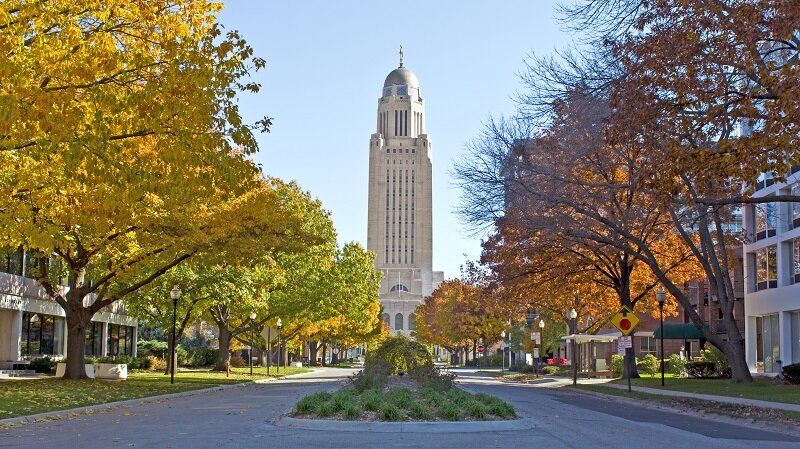
With the cost of living skyrocketing, finding an affordable place to live can feel like an impossible challenge. If you are looking for areas with a lower cost of living, you may consider smaller cities, such as Lincoln, Nebraska.
The state capital of Nebraska, Lincoln has the resources and amenities you would expect in a city. Still, the living costs in Lincoln are less than in more expensive cities. Furthermore, the average cost of living in Lincoln falls below the average living costs in the United States, with a cost of living index under 100.
Relevant expenses to consider when assessing the cost of living in Lincoln include housing costs, bills and utility costs, and food and shopping costs. You should also factor in health and medical costs, which can vary from region to region.
Read on to learn more about the house prices and real estate market in Lincoln, as well as the typical cost of living in Lincoln, Nebraska.
Real Estate Market in Lincoln
The real estate market in Lincoln has experienced quite a boom in the last seven years. The average house price in Lincoln, Nebraska, as of August 2022, was $266,570. You can contrast this with house prices in Lincoln in August 2015, when the average house price was $162,117. Lincoln housing prices have increased by more than nine percent in the past year alone.
However, Lincoln real estate prices will likely go down soon due to the national increase in mortgage rates—with fewer homeowners willing to sell their property and risk-taking on a more expensive mortgage in a new home.
Similarly, if you need to sell a house fast in Lincoln, you will need to anticipate that buyers can not afford higher home prices due to the hike in mortgage rates.
The Lincoln housing market trends already show a slight dip in the summer of 2022, and that drop will likely continue for the rest of the year. You may worry that this is a red flag for the real estate market, but if you look at the price drops in the context of the boom of the last several years, the change is not too severe.
You should still be able to find cash home buyers in Omaha, Lincoln, and other areas of Nebraska.
House selling costs are another relevant factor in the Lincoln real estate market. Most real estate agents in the Lincoln, Nebraska area will charge a commission fee between five and six percent, which is on par with the national average. Other house-selling costs to keep in mind are repair costs, closing costs, and relocation expenses.
Generally speaking, the Lincoln real estate market is still going strong, and the anticipated upcoming dip in house prices may be the perfect time for you to invest in a home in Lincoln.
Costs of Living in Lincoln
In addition to the real estate market, you can look at various lifestyle expenses that impact Lincoln’s average living cost. With the cost of living index of 91.5, practically all of the living costs in Lincoln are less than the national average, demonstrating the city’s comparable affordability.
Bills and Utilities Costs

Most of the utility costs in Lincoln are slightly lower than the national average. For example, the latest cost of living data from the US Bureau of Labor Statistics shows that as of August 2022, the average rates for both electricity and gas bills in the west north central region (which includes Nebraska) are lower than the national average rates.
The August 2022 electricity billing rate for the west north central region of the United States was 14.6 cents per kilowatt hour. You can compare the cost of living with the national average electricity billing rate for August 2022, which was 16.7 cents per kilowatt hour.
Similarly, the average gas heating billing rate in the west north central region is lower than the national rate. For example, in August 2022, the gas rate in the west north central region was $1.558 per therm, and the national average gas rate was $1.694 per therm.
While these differences in rates may appear marginal, the lower energy rates in Nebraska will help you save money on utilities in the long run, especially in the winter months.
Transportation Costs
Overall, transportation costs in Lincoln are less than national averages, which helps contribute to the lower cost of living in Lincoln.
For instance, motor gasoline prices in Lincoln are somewhat lower than the national average and significantly lower compared to regions with expensive gas prices. The average gas price in Lincoln for September was $3.61 per gallon. This rate is about 20 cents cheaper than national trends.
Of course, public transportation should also be included in the cost of living in Lincoln. The main form of public transportation in Lincoln is the city bus. The regular city bus charges a $1.25 fare, and a monthly pass costs $17.00. Children under four years old ride for free.
The bus rates in Lincoln are on the lower end of typical city bus rates in the United States, and the monthly bus pass is a particularly low price compared to other cities’ monthly pass rates.
The gas prices and public transportation costs in Lincoln are comparatively lower than in other parts of the country, making Lincoln an appealing place to live if transportation costs are a concern.
Housing Prices in Lincoln
Housing prices in Lincoln have significantly increased in the past decade. The national real estate boom in recent years has impacted Lincoln home prices and caused a large spike in housing costs.
In August 2022, the median home price in Lincoln was $266,570. Only three years ago, the average home price was $199,477, which is more than a 30 percent increase in housing costs.
When calculating your estimated cost of living in Lincoln, you will want to consider whether you will pay for a condo or a single-family home. The average condo price in Lincoln for August 2022 was $220,473, whereas the average single-family house price for the same month was $268,186.
Rent is also quite affordable in Lincoln, and you should be able to find a one-bedroom apartment with an average rent of under $1,000 per month.
Naturally, housing prices in Lincoln vary by neighborhood and the condition and size of the home. The downtown area of Lincoln will have much higher housing prices, but the more suburban neighborhoods in the city will sell for lower prices.
Fortunately, some of the best places to live in Lincoln are on the more affordable end of the housing price range.
Food and Shopping
Food and shopping costs in Lincoln are marginally less than the national average. You can expect to spend about three or four percent less than the national average prices for food.
For example, the cost of a gallon of milk in Lincoln is usually around three dollars. In comparison, the national average for a gallon of milk has recently risen above four dollars.
Although grocery and shopping costs in Lincoln are more affordable than in many regions in the United States, the difference is small enough that food prices shouldn’t be a major determining factor when assessing the cost of living in Lincoln, Nebraska.
Health and Medical Costs
Unfortunately, most data indicate that health and medical costs in Lincoln may be moderately more expensive than the national average. For example, healthcare premiums often cost around $600 per person, and an out-of-pocket doctor’s visit may also cost somewhat more than the national average.
However, the cost of medical care in Lincoln may not seem exorbitant to you, depending on your current medical care costs. After all, the overall cost of living in Lincoln is still lower than the national average and can offset the minor increase in healthcare prices.
Average Cost of Living in Lincoln
The average cost of living in Lincoln is remarkably close to the average cost of living in the United States. Most data-gathering organizations give Lincoln a cost of living index that is a little under 100, indicating that the cost of living in Lincoln is slightly less than the average United States cost of living.
According to the MIT living wage calculator, which uses a cost of living calculator to estimate how much an individual needs to earn to meet their needs, the living minimum annual salary for a single, childless adult is $34,740 before income taxes.
This amount increases if you have children or live with another adult. Two working adults with two children would need a household income of $99,381.
It’s worth noting that the MIT calculator estimates a lower necessary income in Lincoln for a household with two adults and two children if only one adult works since having a stay-at-home parent decreases childcare costs.
However, you should calculate what your childcare costs would be based on your particular situation before choosing the best option for your family.
Final Thoughts
Lincoln, Nebraska offers many of the perks of city living at a fraction of the cost of most major US cities. Despite inflation and a real estate boom, the cost of living in Lincoln is still less than the average cost of living in the United States.
If you are interested in relocating to Lincoln, don’t hesitate to reach out — we buy houses Nebraska folks would love to live in. Lincoln is an excellent place to call home, with an affordable cost of living and vibrant community culture.
